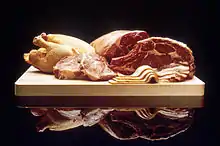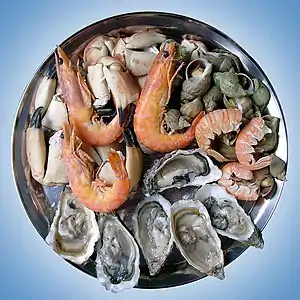Insects as food
Insects as food or edible insects are insect species used for human consumption, e.g., whole or as an ingredient in processed food products such as burger patties, pasta, or snacks.

Edible insects
Frequently consumed insect species
Estimates of numbers of edible insect species consumed globally range from 1,000 to 2,000.[1] These species include 235 butterflies and moths, 344 beetles, 313 ants, bees and wasps, 239 grasshoppers, crickets and cockroaches, 39 termites, and 20 dragonflies, as well as cicadas.[2] Which species are consumed varies by region due to differences in environment, ecosystems, and climate.
The table below lists the top five insect orders consumed by humans worldwide, retrieved from Edible Insects: Future Prospects for Food and Feed Security by Arnold van Huis, Joost Van Itterbeeck, Harmke Klunder, Esther Mertens, Afton Halloran, Giulia Muir and Paul Vantomme.[3]
| Order of insect | Common name | Consumption rate worldwide by human population (%) |
|---|---|---|
| Coleoptera | Beetles | 31 |
| Lepidoptera | Butterflies, moths | 18 |
| Hymenoptera | Bees, wasps, ants | 14 |
| Orthoptera | Grasshoppers, locusts, crickets | 13 |
| Hemiptera | Cicadas, leafhoppers, planthoppers | 10 |
For a list of edible insects consumed locally see: List of edible insects by country.
Edible insects for industrialized mass production
To increase consumer interest in Western markets such as Europe and North America, insects have been processed into a non‐recognizable form, such as powders or flour.[4] Academics as well as large-scale insect food producers such as Entomofarms in Canada, Aspire Food Group in the United States,[5] Protifarm and Protix in the Netherlands, and Bühler Group in Switzerland, focus on four insects species suitable for human consumption as well as industrialized mass production:[6]
- Mealworms (Tenebrio molitor) as larvae
- Lesser mealworms (Alphitobius diaperinus) as larvae, mostly marketed under the term buffalo worms.
- House cricket (Acheta domesticus)
- European migratory locust (Locusta migratoria)
 Freeze-dried mealworms as food (or food ingredient)
Freeze-dried mealworms as food (or food ingredient) Buffalo worms as food (or ingredient)
Buffalo worms as food (or ingredient)_als_Lebensmittel.jpg.webp) House crickets as food (or ingredient)
House crickets as food (or ingredient) Migratory locusts as food (or ingredient)
Migratory locusts as food (or ingredient)
Nutritional profile
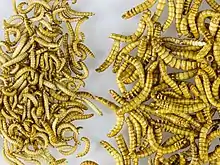
Insects are nutrient efficient compared to other meat sources. Insects such as crickets are a complete protein and contain a useful amount, comparable with protein from soybeans, though less than in casein (found in foods such as cheese).[7] They have dietary fiber and include mostly unsaturated fat and contain some vitamins, such as vitamin B12,[8] riboflavin and vitamin A, and essential minerals.[9][10]
Locusts contain between 8 and 20 milligrams of iron for every 100 grams of raw locust, whereas Beef contains roughly 6 milligrams of iron in the same amount of meat. Crickets are also very efficient in terms of nutrients. For every 100 grams of substance crickets contain 12.9 grams of protein, 121 calories, and 5.5 grams of fat. Beef contains more protein containing 23.5 grams in 100 grams of substance, but also has roughly triple the calories and four times the amount of fat as crickets do in 100 grams.
| Nutritional value per 100 g | Mealworms (Tenebrio molitor) | Buffalo worms (Alphitobius diaperinus) | House crickets (Acheta domesticus) | Migratory locust (Locusta migratoria) |
|---|---|---|---|---|
| Energy | 550 kcal / 2303 KJ | 484 kcal/ 2027 KJ | 458 kcal/ 1918 KJ | 559 kcal/ 2341 KJ |
| Fat Of which saturated fatty acids | 37,2 g 9 g | 24,7 g 8 g | 18,5 g 7 g | 38,1 g 13,1 g |
| Carbohydrates Of which sugars | 5,4 g 0 g | 6,7 g 0 g | 0 g 0 g | 1,1 g 0 g |
| Protein | 45,1 g | 56,2 g | 69,1 g | 48,2 g |
| Salt | 0,37 g | 0,38 g | 1,03 g | 0,43 g |
Farming, production, and processing
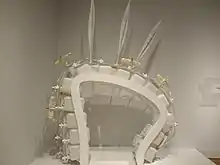
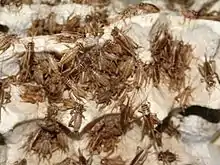
Edible insects are raised as livestock in specialized insect farms. In North American as well as European countries such as the Netherlands or Belgium, insects are produced under strict food law and hygiene standard for human consumption.
Several variables apply, such as temperature, humidity, feed, water sources, housing, depending on the insect species. The insects are raised from eggs to larvae status (mealworms, lesser mealworms) or to their mature form (crickets, locusts), and then killed, in industrialized insect farms by lowering the temperature.[11][12] After that the insects are freeze-dried and packed whole, or pulverized to insect powder (insect flour), to be processed in other food products such as bakery products, or snacks.
Aside from nutritional composition and digestibility, insects are also selected for ease of rearing by the producer. This includes susceptibility to disease, efficiency of feed conversion, developmental rate and generational turnover.[13]
Insect food products
The following processed food products are produced by several producers in North America, Canada, and the EU:
- Insect flour: Pulverized, freeze-dried insects (e.g., cricket flour).
- Insect burger: Hamburger patties made from insect powder / insect flour (mainly from mealworms or from house cricket) and further ingredients.[14]
- Insect fitness bars: Protein bars containing insect powder (mostly house crickets).
- Insect pasta: Pasta made of wheat flour, fortified with insect flour (house crickets or mealworms).
- Insect bread (Finnish Sirkkaleipä): Bread baked with insect flour (mostly house crickets).[15]
- Insect snacks: Crisps, flips or small snacks (bites) made with insect powder and other ingredients.[16]
Food and drink companies such as the Australian brewery Bentspoke Brewing Co and the South-African startup Gourmet Grubb even introduced insect-based beer,[17] a milk alternative, as well as insect ice cream.[18]
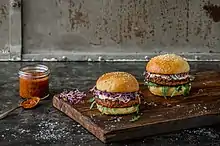 Insect burger made by Essento containing mealworms
Insect burger made by Essento containing mealworms.jpg.webp) Insect energy bar made with processed crickets as ingredient
Insect energy bar made with processed crickets as ingredient Snack made of cricket flour
Snack made of cricket flour Insect snacks (bites) with cultivated cricket flour and oat
Insect snacks (bites) with cultivated cricket flour and oat
Food safety
Challenges and safety concerns
There are some potential challenges caused by production and safety concerns.
Mass production in the insect industry is a concern due to a lack of technology and funds to efficiently harvest and produce insects. The machinery would have to house proper enclosure for each life cycle of the insect as well as the temperature control as that is key for insect development.[19]
The industry also has to consider the shelf life of insects in comparison to animal products as that can have some food safety concerns. Insects have the capability of accumulating potential hazards, such as contaminants, pathogens, the concentration of heavy metals, allergens, and pesticides etc.[20]
Table below combined the data from two studies[21][22] published in Comprehensive Reviews in Food Science and Food Safety, and summarized the potential hazards of the top five insect species consumed by humans.
| Insect order | Common name | Hazard category | Potential hazard |
|---|---|---|---|
| Coleoptera | Beetle | Chemical | Oromones |
| Cyanogentic substances | |||
| Heavy metal contamination | |||
| Lepidoptera | Silkworm | Allergic | |
| Chemical | Thiaminase | ||
| Honeycomb moth | Microbial | High bacterial count | |
| Chemical | Cyanogentic substances | ||
| Hymenoptera | Ant | Chemical | Antinutritional factors (tannin, phytate) |
| Orthoptera | House cricket | Microbial | High bacterial count |
| Hemiptera | Parasitical | Chagas disease | |
| Diptera | Black soldier fly | Parasitical | Myiasis |
Hazards in insects that are shown above can be controlled by various ways. Allergic hazard can be labelled on the package to avoid consumption by allergy susceptible consumers. Selective farming can be used to minimize chemical hazard, whereas microbial and parasitical hazard can be controlled by cooking processes.[23]
Switzerland
On 1 May 2017, Switzerland has approved the following insect species as food:[24]
- House cricket (Acheta domesticus)
- European locust (Locusta migratoria)
- Mealworms (Tenebrio molitor) as larvae
Under certain conditions, these may be offered to consumers as whole animals, pulverized, or processed in food products.
EU
In the EU, insects fall within the definition of novel food as food ingredients isolated from animals, given by the European Commission. Parts of insects, e.g., legs, wings, or heads, as well as whole insects, fall within this definition.[25] Dossiers for several insects species are currently under review by the European Food Safety Authority. In August 2018, EFSA published a risk profile for the house cricket as food.[26] According to a risk assessment published by EFSA on 13 January 2021, the yellow mealworm is safe for human consumption.[27][28]
Awareness
The World Edible Insect Day, being held on 23 October, was introduced by Belgian entrepreneur Chris Derudder in 2015 to raise awareness globally for the consumption of edible insects, with a focus on Europe, North America, and Australia.[29]
See also
Footnotes
- Ramos-Elorduy, Julieta (2009). "Anthropo-Entomophagy: Cultures, Evolution And Sustainability". Entomological Research. 39 (5): 271–288. doi:10.1111/j.1748-5967.2009.00238.x. S2CID 84739253.
- Ramos-Elorduy, Julieta; Menzel, Peter (1998). Creepy crawly cuisine: the gourmet guide to edible insects. Inner Traditions / Bear & Company. p. 150. ISBN 978-0-89281-747-4. Retrieved 2 April 2010.
- van Huis, Arnold. Edible Insects: Future Prospects for Food and Feed Security. Rome. ISBN 9789251075968. OCLC 868923724.
- Melgar‐Lalanne, Guiomar; Hernández‐Álvarez, Alan-Javier; Salinas‐Castro, Alejandro (2019). "Edible Insects Processing: Traditional and Innovative Technologies". Comprehensive Reviews in Food Science and Food Safety. 18 (4): 1166–1191. doi:10.1111/1541-4337.12463. ISSN 1541-4337. PMID 33336989.
- Carson, Erin (12 October 2017). "You're going to be eating crickets, so just get over it". Cnet. Archived from the original on 10 October 2018.
- van, Huis, Arnold (2017-09-15). Insects As Food and Feed: From Production to Consumption. ISBN 9789086862962.
- Van Huis, Arnold (2015). "Edible insects contributing to food security?". Agriculture & Food Security. 4 (20). doi:10.1186/s40066-015-0041-5.
- Schmidt, Anatol; Call, Lisa; Macheiner, Lukas; Mayer, Helmut K. (2018). "Determination of vitamin B12 in four edible insect species by immunoaffinity and ultra-high performance liquid chromatography". Food Chemistry. 281: 124–129. doi:10.1016/j.foodchem.2018.12.039. PMID 30658738.
- https://www.huffingtonpost.com/2014/02/10/eating-bugs-food_n_4726371.html?slideshow=true Here’s Why You Should Start Eating (More) Bugs
- FAO: Edible insects: future prospects for food and feed security. Online: PDF.
- The Atlantic (2015-09-24): "The companies farming crickets for human consumption".
- Forbes (2018-01-39): "Farming The Next Big Food Source: Crickets".
- Oonincx, Dennis G. A. B; Van Broekhoven, Sarah; Van Huis, Arnold; Van Loon, Joop J. A (2015). "Feed Conversion, Survival and Development, and Composition of Four Insect Species on Diets Composed of Food By-Products". PLOS ONE. 10 (12): e0144601. Bibcode:2015PLoSO..1044601O. doi:10.1371/journal.pone.0144601. PMC 4689427. PMID 26699129.
- Food Navigator (2018-10-12): Article on the insect burger by German start-up Bugfoundation.
- Reuters (2017-11-23): Finland baker launches bread made from crushed crickets.
- Bug Burger (2019-3-11): Future food now: Finnish Bugbites and Norwegian mealworm bread.
- Hardy, Karen (22 November 2019). "Hop into a BentSpoke beer made of crickets and flies". Canberra Times. Retrieved 5 April 2020.
- Bailey, Stephanie. "Could this insect ice cream convince you to eat bugs?". CNN. Retrieved 2020-03-01.
- Rumpold, B.A., & Schlüter O.K. (2013) Potential and challenges of insects as an innovative source for food and feed production. Innov Food Sci Emerg Technol 17, 1–11.
- van der Spiegel, M.; Noordam, M.y.; van der Fels-Klerx, H.j. (2013-11-01). "Safety of Novel Protein Sources (Insects, Microalgae, Seaweed, Duckweed, and Rapeseed) and Legislative Aspects for Their Application in Food and Feed Production". Comprehensive Reviews in Food Science and Food Safety. 12 (6): 662–678. doi:10.1111/1541-4337.12032.
- van der Spiegel, M.; Noordam, M.y.; van der Fels-Klerx, H.j. (2013-11-01). "Safety of Novel Protein Sources (Insects, Microalgae, Seaweed, Duckweed, and Rapeseed) and Legislative Aspects for Their Application in Food and Feed Production". Comprehensive Reviews in Food Science and Food Safety. 12 (6): 662–678. doi:10.1111/1541-4337.12032.
- Belluco, Simone; Losasso, Carmen; Maggioletti, Michela; Alonzi, Cristiana C.; Paoletti, Maurizio G.; Ricci, Antonia (2013-05-01). "Edible Insects in a Food Safety and Nutritional Perspective: A Critical Review". Comprehensive Reviews in Food Science and Food Safety. 12 (3): 296–313. doi:10.1111/1541-4337.12014.
- Belluco, Simone; Losasso, Carmen; Maggioletti, Michela; Alonzi, Cristiana C.; Paoletti, Maurizio G.; Ricci, Antonia (2013-05-01). "Edible Insects in a Food Safety and Nutritional Perspective: A Critical Review". Comprehensive Reviews in Food Science and Food Safety. 12 (3): 296–313. doi:10.1111/1541-4337.12014.
- Bundesamt für Lebensmittelsicherheit und Veterinärwesen (2017-04-28): "Insects as food" (German only)
- European Commission (2018-01-03): Questions and Answers: New Novel Food Regulation
- European Food Safety Authority (28 August 2018): Novel foods: a risk profile for the house cricket (Acheta domesticus).
- European Food Safety Authority (13 January 2021): Safety of dried yellow mealworm (Tenebrio molitor larva) as a novel food pursuant to Regulation (EU) 2015/2283. In: EFSA Journal.
- Boffey, Daniel (2021-01-13). "Yellow mealworm safe for humans to eat, says EU food safety agency". The Guardian. Retrieved 2021-01-15.
- Edible Bug Farm (2015-10-03): Interview with Chris Derudder on WEID.
External links
| Wikimedia Commons has media related to Insects as food. |
- FAO: Insects for food and feed
- European Food Safety Authority: Risk profile related to production and consumption of insects as food and feed
Further reading
- van Huis/Tomberlin (2017). Insects As Food and Feed: From Production to Consumption. Wageningen Academic Publishers. ISBN 978-9086862962.
- Dossey, Morales-Ramos and Rojas. Insects as Sustainable Food Ingredients: Production, Processing and Food Applications.
- Shockley and Dossey (2014). "Insects for Human Consumption". Mass Production of Beneficial Organisms: 617–652. doi:10.1016/B978-0-12-391453-8.00018-2. ISBN 9780123914538.
- Calder, Daniel. The Dietitian's Guide to Eating Bugs 2013 ebook
- Dossey, Aaron (2013). "Why Insects Should Be in Your Diet". The Scientist. 27: 22–23.
